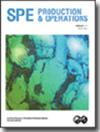基于模型的仿真方法用于海底油田体系结构开发的前端工程设计研究
IF 1.3
4区 工程技术
Q2 ENGINEERING, PETROLEUM
引用次数: 2
摘要
提出了一种基于模型的方法来识别满足预先指定的多物理场约束的海底油田架构。所提出的方法采用多目标优化方法,考虑两个目标函数,即最大限度地减少压力降,从而最大限度地提高生产流量,并最大限度地减少资本支出,从而对已确定的海底系统进行优先级排序。架构解决方案产生歧管定位和最佳的管道路由/尺寸。一种凸组合方法创建了多目标优化标准,可以在诸如水力、拓扑、结构、流动保证、技术问题和财务限制等约束因素之间进行加权。采用一种将分散搜索过程与基于梯度的局部非线性问题求解器相结合的全局多启动算法的混合方法对优化问题进行了计算求解。通过一个案例研究来验证所提出的方法,包括在约束条件之间改变权重的影响。这种深度分析证明了所提出方法的潜力,可以进行一些调查,如井组分析和对整体优化过程的保温效果,以及提供流动保证因素(即海底布局的侵蚀和腐蚀速率)的跟踪工具。因此,我们展示了所提出的基于模型的海底油田布局优化程序的能力。本文章由计算机程序翻译,如有差异,请以英文原文为准。
Model-Based Simulation Approach for Pre-Front End Engineering Design Studies for Subsea Field Architecture Development
Presented is a model-based methodology identifying subsea field architectures that satisfy prespecified multiphysics constraints. The proposed methodology prioritizes the identified subsea system using a multiobjective optimization approach considering two objective functions, which are minimizing pressure drop reflecting the maximization of production flow rates and minimizing capital expenditures. The architecture solutions produce manifolds positioning and optimal pipeline routing/sizing. A convex combination approach creates the multiobjective optimization criterion enabling weighting among constraints such as hydraulic, topological, structural, and flow assurance, as well as technical issues and financial limitations. The optimization problem is computationally solved using a hybrid method with a global multistart algorithm that combines a scatter search process with a gradient-based local nonlinear problem solver. A case study is provided to test the proposed methodology including the effect of varying the weights among the constraints. This deep-dive analysis demonstrates the potential offered by the proposed methodology, illustrated by the ability to perform several investigations such as wells-grouping analysis and insulation effect on the overall optimization procedure, as well as to provide a tracking tool for flow-assurance factors, namely erosion and corrosion rates along the subsea layout. Hence, we present a demonstration of the capabilities of the proposed model-based subsea field layout optimization procedure.
求助全文
通过发布文献求助,成功后即可免费获取论文全文。
去求助
来源期刊

Spe Production & Operations
工程技术-工程:石油
CiteScore
3.70
自引率
8.30%
发文量
54
审稿时长
3 months
期刊介绍:
SPE Production & Operations includes papers on production operations, artificial lift, downhole equipment, formation damage control, multiphase flow, workovers, stimulation, facility design and operations, water treatment, project management, construction methods and equipment, and related PFC systems and emerging technologies.
 求助内容:
求助内容: 应助结果提醒方式:
应助结果提醒方式:


